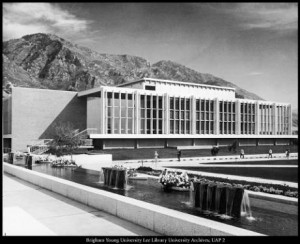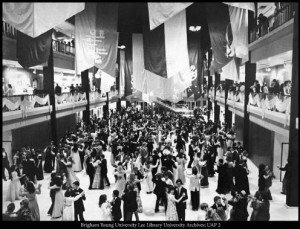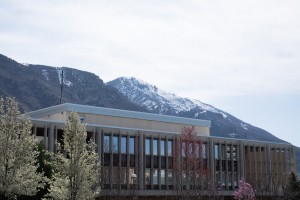The Franklin S. Harris Fine Arts Center has aided in the education and academic success of BYU’s fine arts and communications students for more than 51 years. The HFAC has been home to many major BYU events, arts groups and renowned artists since its dedication on April 3, 1965.
Birth of the HFAC

College of Fine Arts and Communications assistant dean Scott Boyter said the HFAC was constructed as a more functional space for the arts because there was no official arts building at BYU in the university’s early years.
“The fine arts programs were spread in those days onto what we call ‘lower campus,’ which is where the Provo City Library is today,” Boyter said. “There were also some in what we call ‘quonset huts’ that were here on upper campus, which were remnants from WWII.”
BYU announced in 1960 that a new fine arts center would be built to accommodate its growing art programs. William Pereira, whom many recognize for his “futuristic” style of architecture, was chosen to design the building.
Raymond Beckham, a communications faculty member at the time, said he remembers the beginning stages of the HFAC’s construction. He said the building was unique because it was built on an 8-foot-thick concrete base.
“I think in that time and even today, it is quite unusual to put down a solid concrete base for an entire building,” Beckham said. “It was exciting to watch the building grow.”
In 1961, BYU decided that the new arts building under construction would be named the Harris Fine Arts Center after Franklin S. Harris. Harris served as the fifth president of BYU from 1921 to 1945 and organized the College of Fine Arts in 1925.
Boyter said the HFAC was unique from the start because it was one of the first buildings for higher education that put the major fine arts disciplines together. He said the HFAC was also considered unique because its three performance halls provided the ideal space for BYU’s major theater productions.

Start of signature BYU arts groups
BYU’s art programs grew significantly during the late 1960s and 1970s with the addition of the new facility for the arts. Boyter said there was a time in which these programs added about 50 percent more faculty and admitted a lot more students.
This period saw the founding of many well-known BYU art groups such as BYU Synthesis, Theatre Ballet and Lamanite Generation (now known as Living Legends).
Growth of communications
The new HFAC also promoted growth in BYU’s communications programs. KBYU first started operating at the HFAC in 1965, according to Boyter.
“KBYU was a new thing, and that was exciting for students and faculty,” Boyter said.
The arts and communications grew so much that the programs “outgrew the building” over time, according to Boyter. The programs then expanded to the Wilkinson Student Center and the Brimhall building, while the HFAC remained the primary home of these disciplines.
Separation of the arts and communications
BYU’s arts and communications programs continued to develop and outgrow their old spaces. In 2004, Newell Dayley, the dean of the college at the time, made the decision to group the arts programs together in the HFAC and move the communications programs to the newly remodeled Brimhall building.
“I realized that we really did need to get communications into a place of its own and give it its own identity,” Dayley said.
Boyter said grouping arts and communications separately would make the programs more effective and help each program achieve its goals.
“I think it’s worked out to be really good for communications,” Boyter said. “They’ve become a much stronger program with the chance to be together.”
Early events in HFAC history

The HFAC hosted the Mormon Festival of the Arts from 1969 to 1982. The festival was organized as an effort to promote Mormon values and ideas in art and music, according to Boyter.
These annual festivals featured concerts, plays, readings, symposiums, recitals and other art exhibits from Mormon artists, which were presented over the course of several days.
The HFAC also hosted the Mormon Arts Ball in 1974, a concert featuring the Philharmonic Orchestra and other classical artists along with a formal dance with music from the symphony orchestra.
Influence and outreach

Dayley said one of the things he liked best about the HFAC over his 43 years serving there was its ability to be adjusted according to the constantly changing needs of students and faculty.
“It’s been marvelously adaptable,” Dayley said. “In some ways it’s been too small for what’s been in it, but it was built in such a way that it’s been adaptable, and I really appreciate that about it.”
The HFAC has housed the arts and communications majors of well-known graduates such as Mack Wilberg, Kurt Bestor, Brett Helquist and Jane Clay Johnson throughout its functioning years.
“The building is brick-and-mortar, but what makes a difference are the people,” Boyter said.




